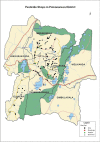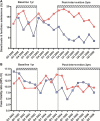Effects of a provincial ban of two toxic organophosphorus insecticides on pesticide poisoning hospital admissions
- PMID: 22372788
- PMCID: PMC3793265
- DOI: 10.3109/15563650.2012.660573
Effects of a provincial ban of two toxic organophosphorus insecticides on pesticide poisoning hospital admissions
Abstract
Background: Pesticide self-poisoning causes one third of global suicides. Sri Lanka halved its suicide rate by banning WHO Class I organophosphorus (OP) insecticides and then endosulfan. However, poisoning with Class II toxicity OPs, particularly dimethoate and fenthion, remains a problem. We aimed to determine the effect and feasibility of a ban of the two insecticides in one Sri Lankan district.
Methods: Sale was banned in June 2003 in most of Polonnaruwa District, but not Anuradhapura District. Admissions with pesticide poisoning to the district general hospitals was prospectively recorded from 2002.
Results: Hospital admissions for dimethoate and fenthion poisoning fell by 43% after the ban in Polonnaruwa, while increasing by 23% in Anuradhapura. The pesticide case fatality fell from 14.4% to 9.0% in Polonnaruwa (odds ratio [OR] 0.59, 95% confidence interval [CI] 0.41-0.84) and 11.3% to 10.6% in Anuradhapura (OR 0.93, 95%CI 0.70-1.25; p = 0.051). This reduction was not sustained, with case fatality in Polonnaruwa rising to 12.1% in 2006-2007. Further data analysis indicated that the fall in case fatality had actually been due to a coincidental reduction in case fatality for pesticide poisoning overall, in particular for paraquat poisoning.
Conclusions: We found that the insecticides could be effectively banned from agricultural practice, as shown by the fall in hospital admissions, with few negative consequences. However, the ban had only a minor effect on pesticide poisoning deaths because it was too narrow. A study assessing the agricultural and health effects of a more comprehensive ban of highly toxic pesticides is necessary to determine the balance between increased costs of agriculture and reduced health care costs and fewer deaths.
Figures




Similar articles
-
Acetylcholinesterase inhibitor insecticides related acute poisoning, availability and sales: trends during the post-insecticide-ban period of Anuradhapura, Sri Lanka.Environ Health Prev Med. 2018 Jun 26;23(1):27. doi: 10.1186/s12199-018-0716-1. Environ Health Prev Med. 2018. PMID: 29945568 Free PMC article.
-
Suicides by pesticide ingestion in Pakistan and the impact of pesticide regulation.BMC Public Health. 2023 Apr 11;23(1):676. doi: 10.1186/s12889-023-15505-1. BMC Public Health. 2023. PMID: 37041526 Free PMC article. Review.
-
Influence of pesticide regulation on acute poisoning deaths in Sri Lanka.Bull World Health Organ. 2003;81(11):789-98. Epub 2004 Jan 20. Bull World Health Organ. 2003. PMID: 14758405 Free PMC article.
-
Bans of WHO Class I Pesticides in Bangladesh-suicide prevention without hampering agricultural output.Int J Epidemiol. 2018 Feb 1;47(1):175-184. doi: 10.1093/ije/dyx157. Int J Epidemiol. 2018. PMID: 29024951 Free PMC article.
-
Suicide by pesticide poisoning in India: a review of pesticide regulations and their impact on suicide trends.BMC Public Health. 2020 Feb 19;20(1):251. doi: 10.1186/s12889-020-8339-z. BMC Public Health. 2020. PMID: 32075613 Free PMC article. Review.
Cited by
-
Acetylcholinesterase inhibitor insecticides related acute poisoning, availability and sales: trends during the post-insecticide-ban period of Anuradhapura, Sri Lanka.Environ Health Prev Med. 2018 Jun 26;23(1):27. doi: 10.1186/s12199-018-0716-1. Environ Health Prev Med. 2018. PMID: 29945568 Free PMC article.
-
Use of OpdA, an organophosphorus (OP) hydrolase, prevents lethality in an African green monkey model of acute OP poisoning.Toxicology. 2014 Mar 20;317:1-5. doi: 10.1016/j.tox.2014.01.003. Epub 2014 Jan 18. Toxicology. 2014. PMID: 24447378 Free PMC article.
-
Social and economic variables related with Paraquat self-poisoning: an ecological study.BMC Public Health. 2020 Mar 27;20(1):404. doi: 10.1186/s12889-020-08510-1. BMC Public Health. 2020. PMID: 32220225 Free PMC article.
-
Suicides by pesticide ingestion in Pakistan and the impact of pesticide regulation.BMC Public Health. 2023 Apr 11;23(1):676. doi: 10.1186/s12889-023-15505-1. BMC Public Health. 2023. PMID: 37041526 Free PMC article. Review.
-
The effect of sodium fluoride, formaldehyde, and storage temperature on the stability of methamidophos in post-mortem blood and liver.Int J Legal Med. 2017 May;131(3):667-675. doi: 10.1007/s00414-016-1518-x. Epub 2016 Dec 19. Int J Legal Med. 2017. PMID: 27990599
References
-
- Wesseling C, McConnell R, Partanen T, Hogstedt C. Agricultural pesticide use in developing countries: health effects and research needs. Int J Health Serv. 1997;27:273–308. - PubMed
-
- Wesseling C, Aragon A, Castillo L, Corriols M, Chaverri F, de la Cruz E, et al. Hazardous pesticides in Central America. Int J Occup Environ Health. 2001;7:287–294. - PubMed
-
- World Health Organization. World Health Report 2001. Mental health: new understanding, new hope. Geneva: World Health Organization; 2001.
Publication types
MeSH terms
Substances
Grants and funding
LinkOut - more resources
Full Text Sources
Medical
Miscellaneous
